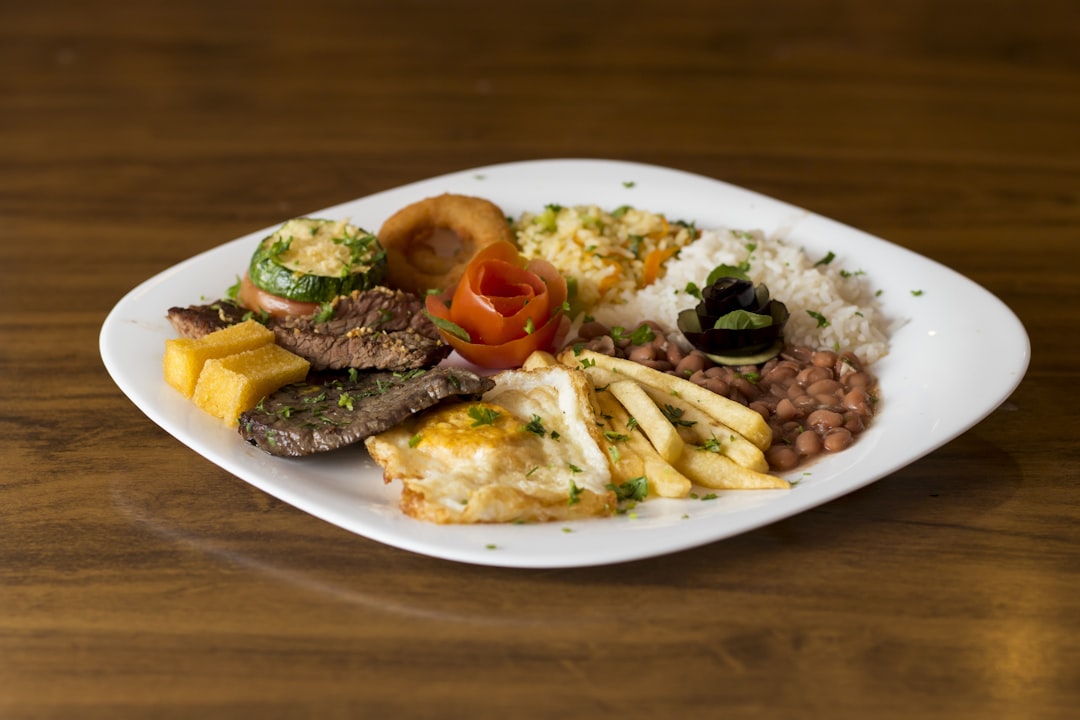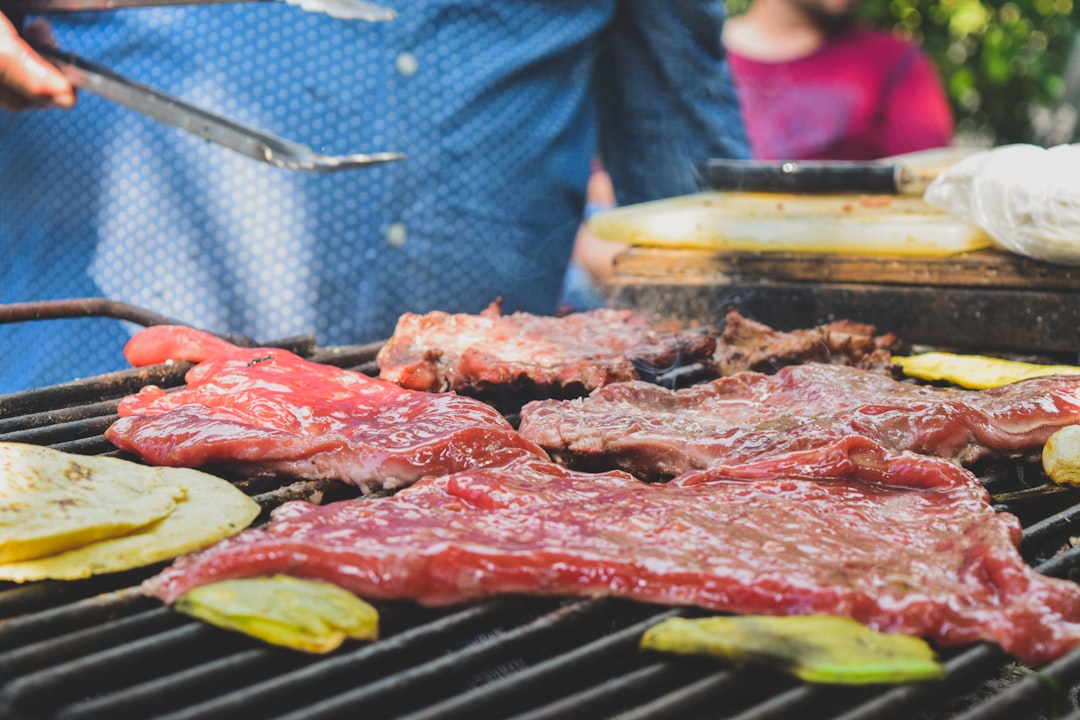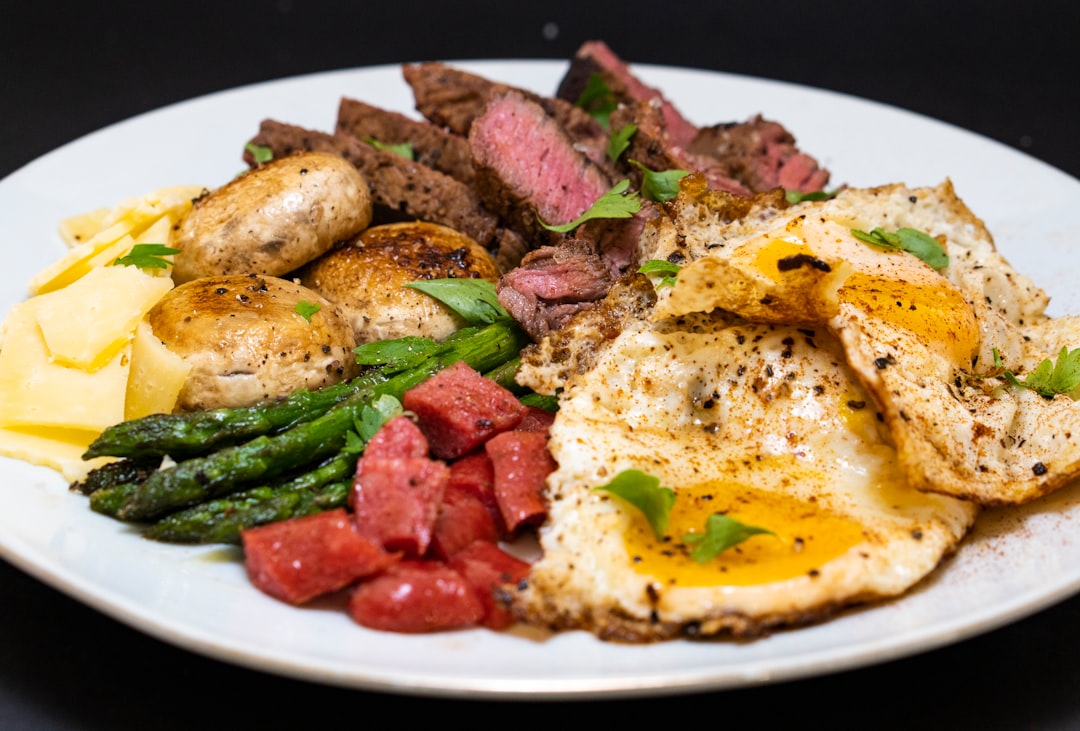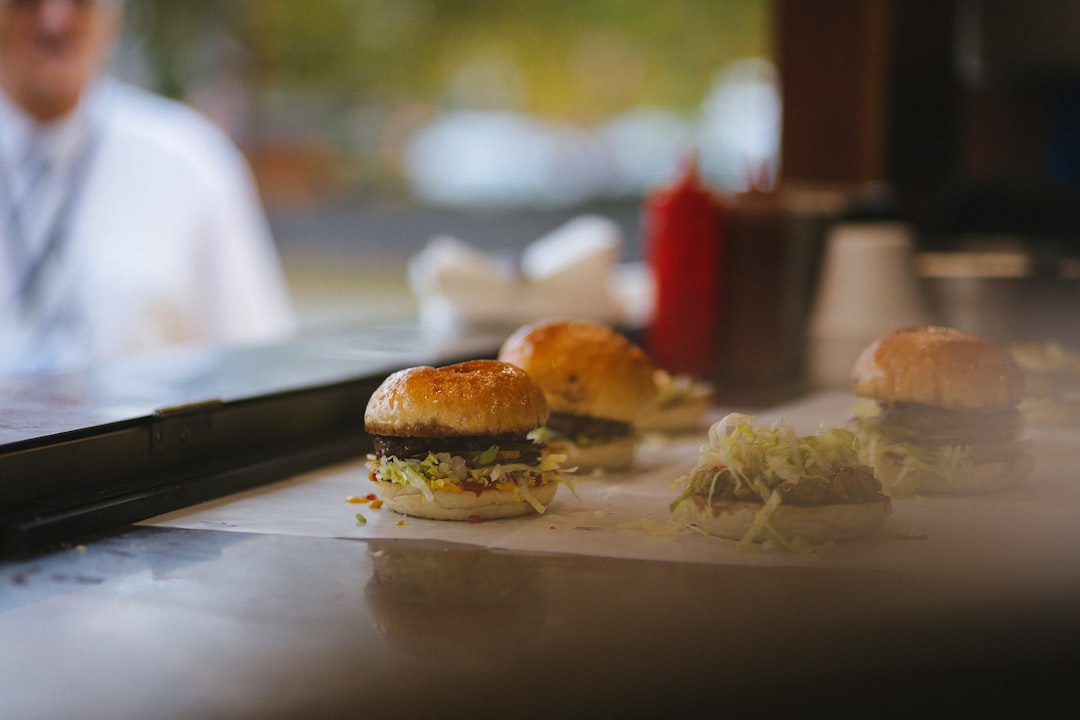Steak
First, select the right cut. Choose a well-marbled steak, preferably of grass-fed, hormone-free origin. Cuts such as rib-eye, New York strip, and filet mignon are all excellent choices. A decent butcher should be able to help you with your selection.
Next, let your steak come to room temperature before cooking. This step helps ensure that the steak cooks evenly throughout. Aim for about 15 minutes of sit time prior to cooking.
Finally, season liberally and cook to perfection. Don't skimp on the seasoning with salt, pepper, and maybe some garlic and herbs for maximum flavor. When it comes to cooking, a cast-iron skillet and some olive oil can do wonders. The key is to render the fat for a crusty finish and juicy interior - aim for a medium-rare finish (about 140-145 degrees F).
With those simple steps, you'll be able to produce a delicious, restaurant-quality steak at home! Just remember to let it rest for ten minutes after it's done cooking, or you may be greeted with a chewy disappointment.
Steak dishes
A selection of Steak dishes.
Cheesesteak
The cheesesteak: a dish of divine proportions. A rich and robust combination of steak, cheese, and bread that has been tantalizing taste buds around the world for decades. But what makes this iconic sandwich so facinating? Let's explore the culinary nuances of this remarkable dish.
CheesesteakBeef Wellington
Beef Wellington is a timeless classic that is sure to garner appreciation and accolades from all who partake. It's tender, succulent chunks of beef encased in a golden and flaky puff pastry, providing a delicious and sumptuous flavor. The combination of the grass-fed beef, béchamel sauce, Dijon mustard, mushrooms, and prosciutto ham creates an unrivaled gastronomic adventure.
Beef WellingtonMongolian beef
Mongolian Beef is one of the most succulent and savory dishes out there. It's a classic example of the perfect blend of marinated beef, caramelized onions and fermented black beans, all served up in a flavorful, sauce-laden stir-fry. The flavors and textures work together in a harmonious symphony that will tantalize your taste buds and leave you wanting more.
Mongolian beefPot roast
Pot roast is the stuff of classic American comfort foods; an unknowable amalgam of flavors, textures, and aromas that have been captive within the confines of a Dutch oven or slow cooker for hours and days, simmering until hunger and appetite are fully satiated.
Pot roastSha cha beef
Ever since its introduction to the western world in 2012, Sha cha beef has quickly become a favorite among Asian food enthusiasts. From the first moment its savory aroma wafts into your nostrils, it's easy to understand why. With its complex blend of spices and bold flavors, Sha cha beef certainly packs a daring punch.
Sha cha beefPittsburgh rare
Pittsburgh rare is a delectable dish that has been captivating the taste buds of Western Pennsylvania since the late 19th century. This hearty meal is a simple yet delicious combination of hamburger steak, fried onions, and French fries. Though ground beef is traditionally used to prepare the hamburger steak, local chefs have also utilized their own unique concoctions featuring sirloin and ribeye.
Pittsburgh rareAsado
Asado is an Argentinean dish that is simply divine. It is a type of slow roasted barbeque and is a staple in South American culture. Made from the highest-quality cuts of beef and seasoned with traditional herbs and spices, Asado is a savory and succulent experience unlike any other.
AsadoCarpetbag steak
Ah, the delectable Carpetbag steak. An Australian classic that's sure to make your taste buds euphorically dance with delight. Much like the country itself, the dish is a rich blend of old-world simplicity, yet it boasts a delightful complexity that is not to be underestimated.
Carpetbag steakChateaubriand (dish)
Chateaubriand is a classic French dish that is beloved by gourmands the world over. It is a thick cut of beef tenderloin served with a sauce made of pan-drippings and a typically served with mushrooms, potatoes, and green beans. The dish is named after Francois René de Chateaubriand, a 19th century French author.
Chateaubriand (dish)Delmonico steak
Delmonico steak is a mouth-watering cut of beef that has been cherished by diners for centuries. Originating in the mid-19th century, this succulent steak was first served in the now-famous Delmonico's Restaurant in New York City. This culinary mainstay has since become a favorite of steak aficionados all over the world.
Delmonico steakFajita
Ah, fajitas. A dish almost so ubiquitous in Mexican-style restaurants that it's easy to overlook. But don't be fooled. With their sizzling, spiced flavor and undeniably appetizing presentation, this delectable steakless dinner is a sure way to tantalize the taste buds.
Fajitaskirt steak
Skirt steak is one of the most tasty and succulent cuts of beef around. This lean yet flavorful cut of meat is taken from the cow’s diaphragm, or “skirt” muscle, and can easily be the star of any barbecue. The best way to get the most delectable flavor out of skirt steak is to marinate it in a mixture of garlic, herbs, and oil, before grilling or pan-searing it.
skirt steakFinger steaks
Ah, finger steaks. The tantalizing treat that's sure to tantalize your taste buds. But what exactly are they? Finger steaks are a traditional dish that originates from Idaho, America. It's an original take on steak bites. They're made with thin strips of steak, usually sirloin or round, that are battered and deep fried.
Finger steaksLondon broil
London Broil, a classic dish that has been making tongues wag in the culinary world for centuries. London Broil is a steak-centric meal that has earned its spot among the stars of British cuisine. Traditionally, London Broil involves marinating and then grilling a piece of steak (usually flatiron, flank or top round) to the desired doneness.
London broilSalisbury steak
Ah, Salisbury steak. It's a classic comfort dish with a rich history and a plethora of tantalizing tastes. It's composed of beef that has been shaped into a patty and usually served with gravy, mushroom sauce, potatoes, or onion. It also features a number of ingredients like onions, parsley, and Worcestershire sauce.
Salisbury steakStanding rib roast
Ah, the standing rib roast: an iconic and majestic dish destined to leave any dinner guest with an unmitigated sense of satisfaction. While the mere mention of its name may bring about salutations amongst carnivores, achieving its culinary perfection is no mean feat.
Standing rib roastSteak and eggs
It is hard to beat a classic dish such as steak and eggs. This time-honored combination is one of the simplest yet most sublime meals that can be had. The succulent, juicy steak coupled with the rich, creamy eggs create a banquet for the palate.
Steak and eggsSteak and kidney pie
As the old saying goes, there is nothing better than a hearty homemade steak and kidney pie. This classic British dish is renowned for its comforting combination of succulent beef, flavorful kidneys and fluffy potatoes cloaked in a mouthwatering crust.
Steak and kidney pieSteak au poivre
No matter if you are a culinary novice or a seasoned foodie, the scent and sound of sizzling steak au poivre is more than enough to tantalize your taste buds. This delicious French delicacy is crafted out of high-quality premium steak and adorned with flecks of black peppercorns that give it an unmistakably pungent flavor.
Steak au poivreSteak de Burgo
Steak de Burgo is a culinary masterpiece of Latin-inflected steak, loaded with the robust flavors of garlic, parsley, and olive oil. This unctuous, succulent, and decadent dish hails from the region of Burgos in Spain. A true representation of Spanish cuisine, it is a quintessential combination of simple ingredients that come together in extraordinary fashion.
Steak de BurgoSteak Oscar
Steak Oscar is a delicious and luxurious dish that combines tender, juicy steak with savory crab and creamy Bearnaise sauce. It's usually served over a bed of fluffy white rice or roasted potatoes. The name of the dish comes from King Oscar II of Sweden, who is said to have enjoyed this decadent meal.
Steak OscarSteak sandwich
When I think of a steak sandwich, I think of pure culinary indulgence. It's as if the sandwich is inviting you to a decadent feast that tantalizes all the senses. And when it's carefully crafted and prepared with the highest quality ingredients, I feel an unbeatable sense of gastronomical delight.
Steak sandwichSteak
Steak is one of the most beloved dishes in the world and, it can be argued, a staple when it comes to celebrating special occasions. From a juicy ribeye to a succulent filet mignon, steak is an incredibly versatile food that lends itself to a myriad of preparation and flavor combinations. While steak is notably juicy and flavorful all on its own, there are a number of quintessential pairings that both accentuate and elevate the dish to an even greater level.
For starters, steak and potatoes is a classic combination with deep roots in traditional cuisine. While steak and potatoes can come in a variety of preparations, ranging from fried to grilled, the pairing remains a tried and true favorite. The beautiful contrast between the buttery texture of the potatoes – whether you prefer mashed or roasted – and the richly marbled steak, makes for a timeless taste profile.
Another classic pairing for steak is a delicate sauce, such as an béarnaise or a red wine demi-glace. Not only does the comforting creaminess of the sauce complement the steak's slightly charred crust, but its finishing flavor notes add a touch of complexity that takes the dish to the next level of elegance.
For those who truly want to explore the possibilities of steak, adding seasonal vegetables to the mix is a great way to create a full meal that provides a burst of flavor in each bite. For example, asparagus and mushrooms, sautéed in butter, are a wonderfully savory accompaniment to a medium rare filet mignon. Or, grilled bell peppers and onions, seasoned with salt and pepper, bring a smokiness that pairs perfectly with a ribeye.
No matter how it is enjoyed, chances are steak will continue to be a favorite for years to come. In addition to its versatility, the ability to cook steak to perfection allows for a personalized dining experience that can be enjoyed time and time again.
History of Steak
As a staple of so many dinner tables and dinner dates, one might assume that steak has been around for as long as we can remember. However, the history of this delicious dish is actually quite fascinating.
For starters, it is believed that the word “steak” itself is derived from the Old Norse word “steikja” which translates to “roast meat.” This is likely due to the fact that the ancient Norse people would typically cook their meat by roasting it over open fires.
While steak had been a part of the dinner table in some form or another for centuries, the modern version began to emerge in the early 19th century. This transition was largely thanks to French chef Marie-Antoine Careme, who introduced the concept of searing the steak in butter rather than simply roasting it over the fire. His technique of cooking the steak on both sides quickly spread across Europe, eventually finding its way to North America.
Since then, steak has become an integral part of many cuisines around the globe, and is prepared in innumerable ways. Whether it’s grilled, pan-fried, served with a variety of sauces or and accompanied by a side dish, it has become one of the most beloved dishes across all cultures.
So the next time you bite into your steak, take a moment to appreciate the fascinating history behind it. Who knows, you may just discover a newfound appreciation for this age-old classic!










































